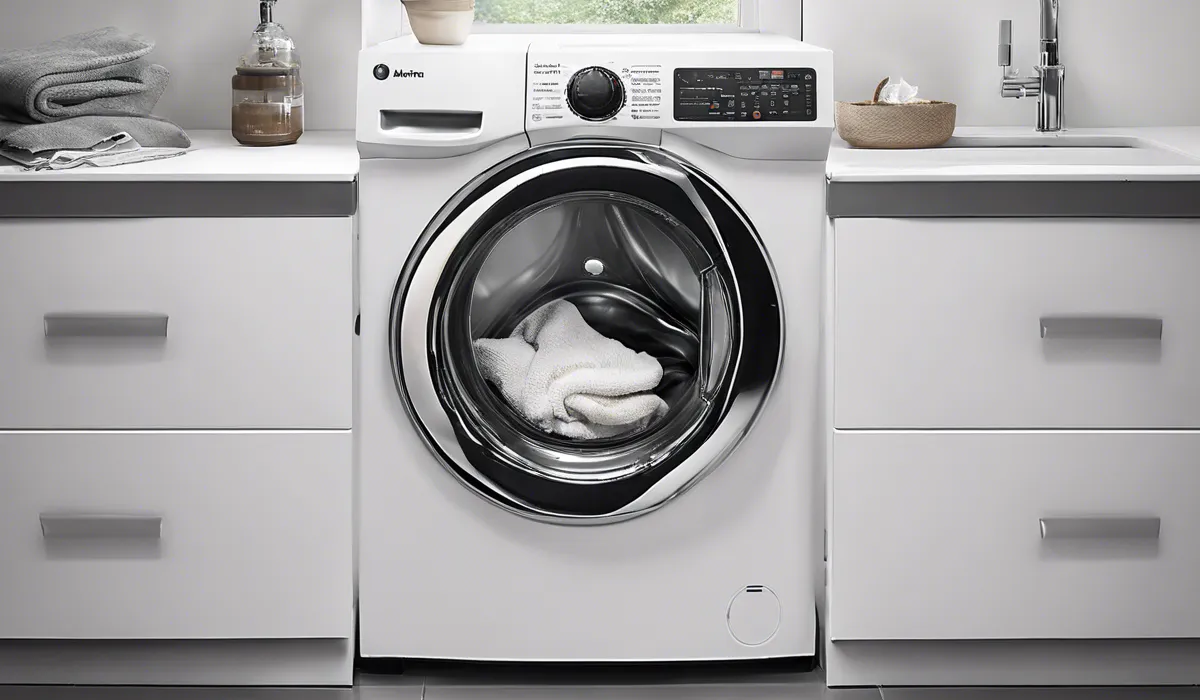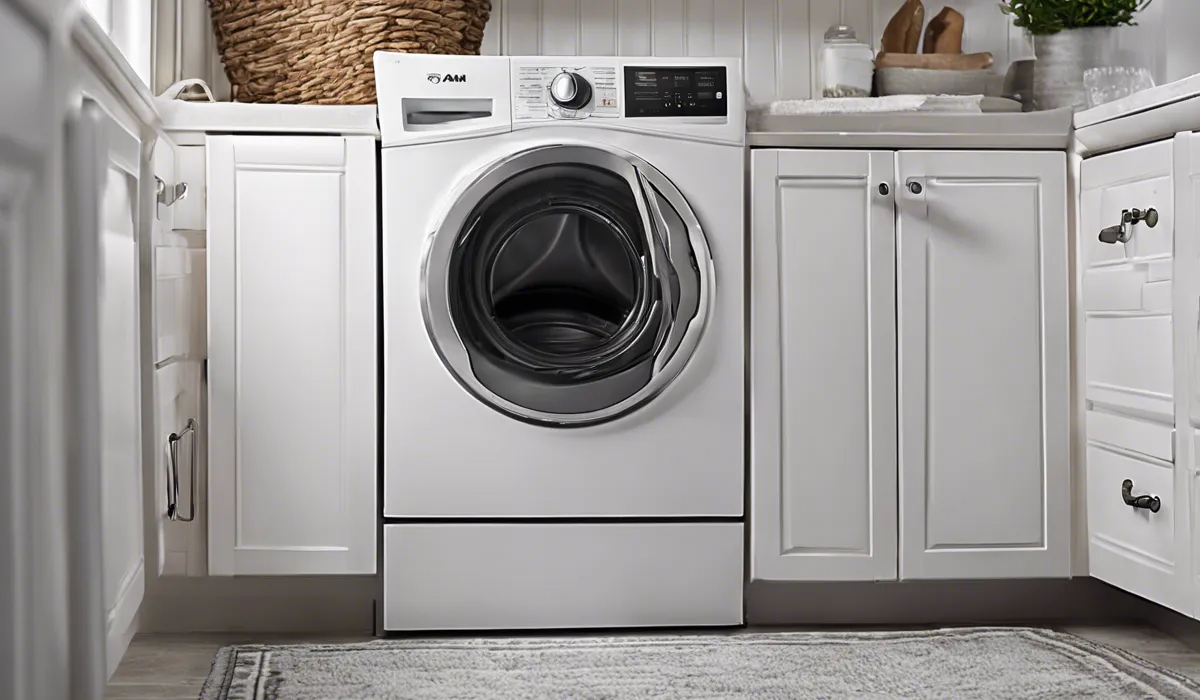To remove a mildew smell from a front load washer, clean the gasket with a mixture of hot water and vinegar, then run a hot wash cycle with 2 cups of vinegar. Leave the door open between washes to dry out the drum and prevent mildew.
Causes of Mildew Smell in Front Load Washers

Front Load Washer Design Specifics
Front load washers are popular for their efficiency and gentle washing action, but their design can contribute to unwanted smells.
The door seal, or gasket, is designed to keep water from leaking out during the wash cycle. However, this tight seal can also trap moisture inside the machine after the laundry is done, creating an environment where mildew can thrive.
Moisture: The Breeding Ground for Mildew
Moisture left in the washer after use can lead to the growth of mold and mildew. These fungi love damp environments, and a washer’s drum is the perfect place for them to settle.
If the washer is not dried out properly after each use, it doesn’t take long for a musty smell to develop.
Detergents and Softeners as Mold Food
Residual detergent, fabric softener, and even organic material from clothes can act as food sources for mold.
When these substances build up within the washer, they can create a layer of grime that molds feed on, making the mildew smell even more pronounced.
Effects of Poor Ventilation and Infrequent Use
Washers located in poorly ventilated areas or those that are not used regularly can suffer more from mildew issues.
Without adequate airflow to dry out remaining moisture, and with extended periods between washes allowing mold to grow undisturbed, the problem of bad odors can intensify.
Cleaning and Removing Mildew Smell from Your Washer

Preparing for Cleaning: Empty and Inspect
Before you begin the cleaning process, make sure your washer is empty. Check for visible signs of mold or mildew, especially around the gasket.
Pay close attention to any areas that seem to retain water or have a noticeable smell.
Selecting Your Cleaning Agents
When tackling mildew smells, vinegar, baking soda, and bleach are your best allies. Vinegar is a natural disinfectant and deodorizer, while baking soda can absorb and neutralize odors.
For more severe cases, bleach is effective at killing mold and mildew, but should be used with caution.
Cleaning Steps for Your Washer
Start by running a hot water cycle with 2 cups of vinegar added to the drum. This will help to break down any residue and start the disinfection process.
Next, mix vinegar or bleach with hot water and use this solution to thoroughly wipe down the gasket, drum, and door. Take the time to clean out the detergent dispenser and any removable parts, as these can harbor mold too.
After the initial cleaning, run another hot water cycle, this time with a cup of baking soda added to the drum.
This will help to further neutralize any lingering odors. Once complete, leave the door open to allow the washer to air dry completely.
Addressing Stubborn Mildew Issues
If after cleaning, you still notice a mildew smell, repeat the process with stronger solutions or consider a commercial mold and mildew remover.
Persistently damp areas may need additional attention and possibly the replacement of seals or other parts.
Preventative Measures to Keep Your Washer Fresh

Proper Washer Use and Maintenance
One of the simplest ways to prevent mildew is to keep the washer door and detergent drawer open between uses.
This allows air to circulate and dry out any moisture. Also, make sure you are using the right amount of high-efficiency (HE) detergent, as overuse can lead to excess suds and residue.
Quickly Removing Wet Laundry
Removing your laundry promptly after the cycle will not only keep your clothes fresh but also prevents moisture from sitting in the washer drum longer than necessary.
This is an easy habit to form that can have a big impact on preventing mildew.
Regular Maintenance Washes
Periodically run a maintenance wash with hot water to cleanse the washer. This helps to flush out any residue and keep the internal components clean.
If you live in a hard water area, you may also need to descale your washer regularly.
Mold-Resistant Products and Routine Cleaning
Consider using mold-resistant washer products like gasket covers or antimicrobial cleaners.
Additionally, keep up with routine checks and clean the washer components, such as the filter and hose, to prevent the buildup of lint and debris that can trap moisture.
FAQs About Removing Mildew Smell from Front Load Washer
How can I clean the gasket of my front load washer to eliminate mildew smell?
To clean the gasket and remove the mildew smell, use a mixture of hot water and vinegar to thoroughly wipe down the gasket.
What should I run through a hot wash cycle to get rid of a mildew smell?
Run a hot wash cycle with 2 cups of vinegar to help remove the mildew smell from your front load washer.
Is it necessary to leave the washer door open after cleaning to prevent mildew?
Yes, leave the washer door open between washes to allow the drum to dry out and prevent the growth of mildew.
Can I use bleach instead of vinegar to remove the mildew smell from my washer?
It’s recommended to use vinegar for a natural solution, but bleach can also be used as an alternative in a separate wash cycle if your washer manufacturer approves.
How often should I clean my front load washer to keep it free of mildew smell?
Clean your washer monthly or as needed when you notice a mildew smell to maintain its freshness.
Final Thoughts
To combat mildew odor in a front load washer, thoroughly scrub the gasket with a hot water and vinegar solution.
Follow this by running a hot wash cycle with 2 cups of vinegar. To prevent future mildew, ensure the drum is dry by leaving the door ajar between uses.
